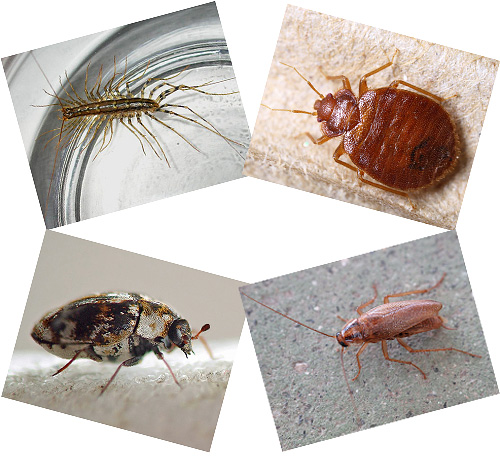
Domestic insects are so diverse that there are not enough fingers to list even their main representatives. Nevertheless, you can still try to classify them: for example, according to the degree of harmfulness and danger to humans. And so that the reader can always quickly understand who exactly he just met in his home, photos of domestic insects with names will be given below.
So, all domestic insects can be divided into the following groups:
- Household parasitic insects are those insects in the house that bite a person and feed on his blood. Parasites include bedbugs, mosquitoes, lice and fleas that temporarily or permanently live near a person and are able to breed in his home.

- Pests are those arthropods that do not directly touch a person, but actively harm various objects in the house or food, making them unusable. These include well-known cockroaches, moths, springtails, whiteflies, ants, termites, wood lice, leather beetles, and book lice.

- Harmless cohabitants who do not pose a danger to humans and do not cause any harm to the house. These are small spiders, silverfish, flycatchers and centipedes.

You can also highlight another group of insects in the house - the so-called random "guests" who fly in through the window, "arrive" on clothes or crawl into the living room themselves. Among them, in particular, there may be parasites already noted above, for example, ticks or mosquitoes, pests such as beetles and flies, and relatively harmless insects - forest bugs, bees and wasps, lacewings and many others.
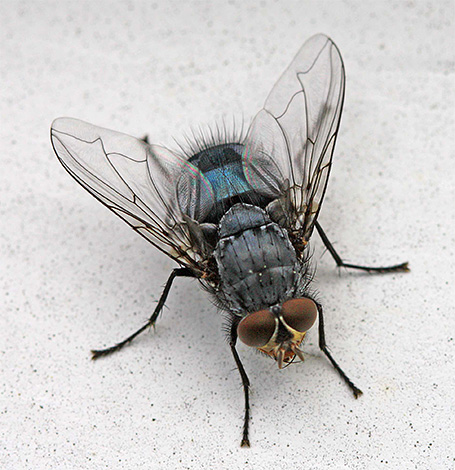
However, most of them are still not domestic insects, so we will talk further about the first three groups.
It is worth noting that many of the small arthropods in the house - to be precise - are not insects at all. For example, these are wood lice, centipedes and spiders, which are called insects out of ignorance or simply for convenience. Nevertheless, we will tell about them further with photos and names, so that the owner of the apartment can certainly identify his roommates if necessary.
Cockroaches in the house: dirt and unsanitary conditions
Cockroaches are perhaps the most famous domestic pests. The photo below shows their species that settle in apartments - naturally, against the will of the owners.
Of course, the first place is occupied by one of the most numerous and well-known household insects - the red cockroach (which also has another name "Prussian"):
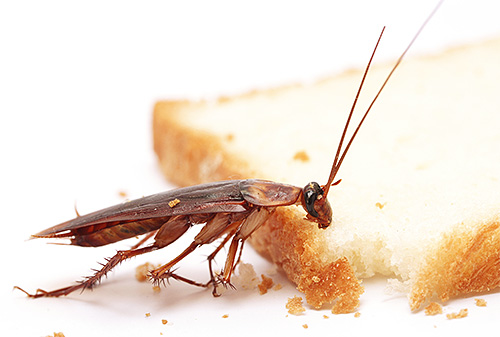
The second species, quite familiar to our latitudes, is the black cockroach (Latin name Blatta orientalis). This is a relatively large domestic insect, gradually disappearing under the onslaught of its red counterpart (the Prussian actively eats the eggs of a black cockroach).
Photo of a black cockroach:
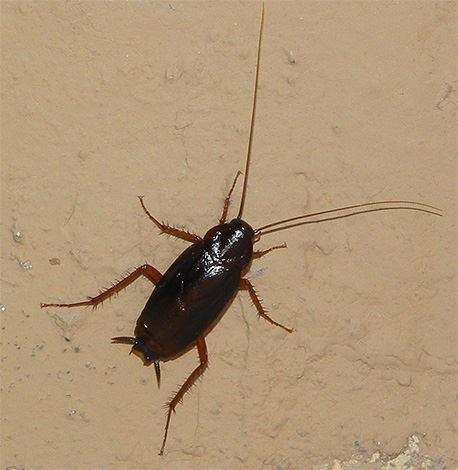
The third type of these pests is the American cockroach (Latin name Periplaneta americana):
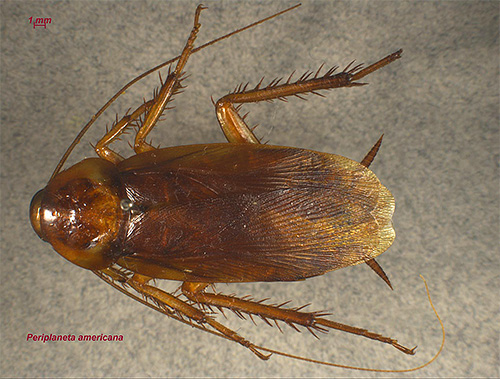
Initially, it was extremely rare for our country, however, with the development of international trade, this species began to conquer warehouses and shops of large metropolitan areas, and only after that - living quarters located in the neighborhood.
The key to successful "occupation" of human housing by these domestic pests lies in the features of their biology. Cockroaches are insects that feed on absolutely any food waste in the house, as well as many other household items - for example, various adhesives, shoe polish, paper. In addition, they can do without food for quite a long time - sometimes even up to 20 days.
Below are a few more photos of these household pests:
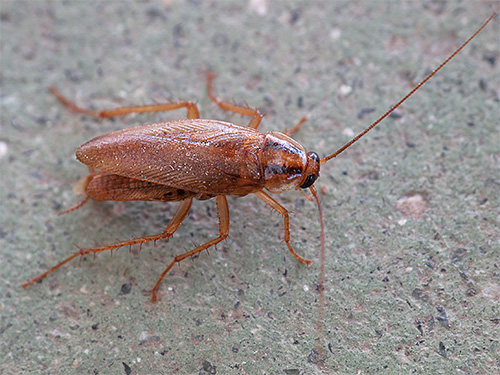
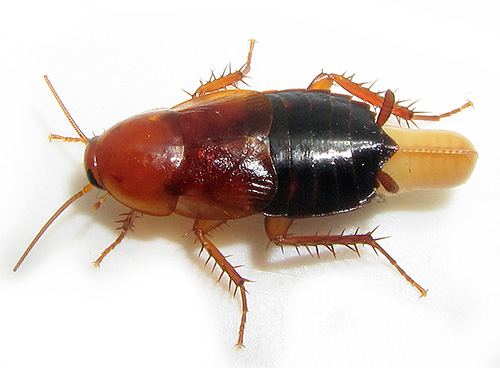
Cockroaches breed very quickly, and the life expectancy of an adult is approximately 9-16 months.
In addition to the obvious harm that cockroaches cause to various food products (they eat, pollute them), they, among other things, are carriers of various infectious diseases and even eggs of some helminths.
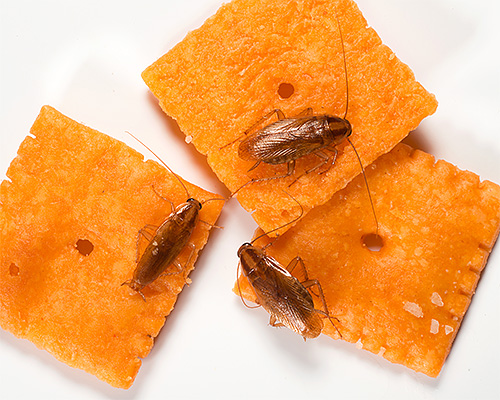
Therefore, the fight against these domestic insects must be carried out without fail.
Bed bugs: who bites at night
Bed bugs are one of the most annoying household pests. The main harm that they cause to a person is, of course, bites. And although today there are no scientifically proven facts that these parasites infect with any infectious diseases, nevertheless, dangerous pathogens have been repeatedly found in their bodies.
In the photo - a nest of these small parasites in the mattress:
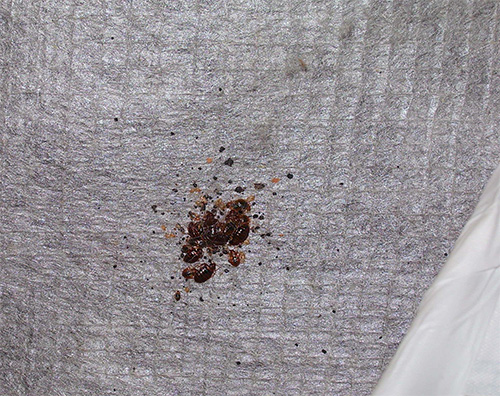
And then in the photo - adult bugs, their larvae and eggs:

Bedbugs can live in almost any secluded place in an apartment, but here they multiply at an incredible rate. Being typical parasites, at night these insects crawl onto the bed, bite a person and suck his blood. Interestingly, the larvae begin to feed from the first days of life and differ from adult bugs only in their size.
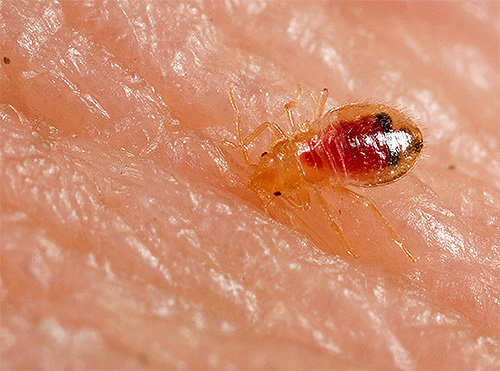
Generally speaking, several types of bed bugs can parasitize in a person’s house, but it is almost impossible to distinguish them from each other without a microscope and certain knowledge.
In the photo - bedbugs drunk with blood:
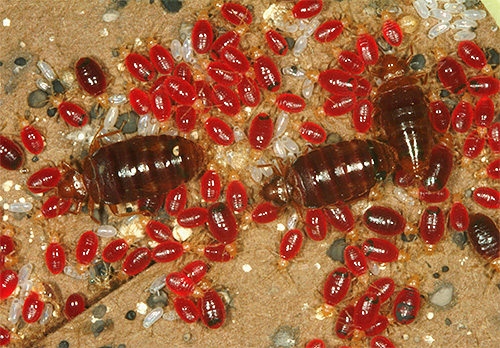
To poison these small parasites in general is much more difficult than cockroaches, since a significant proportion of the available insecticidal preparations are simply powerless against them. Usually, special aerosol insecticides, sprays, and sometimes dusts are used to exterminate bedbugs. Very effective is the destruction of bedbugs with cold fog.
house ants
Ants are one of the most difficult household pests to eradicate. Most often, in a person’s apartment, you can meet representatives of two types of these insects - red house ants, also called pharaoh ants, and thieves ants. For a layman, it will be rather difficult to distinguish between these two species, but, nevertheless, pharaoh ants are still more frequent guests in human dwellings.
In the photo - pharaoh ants on the kitchen table (Latin name Monomorium pharaonis):
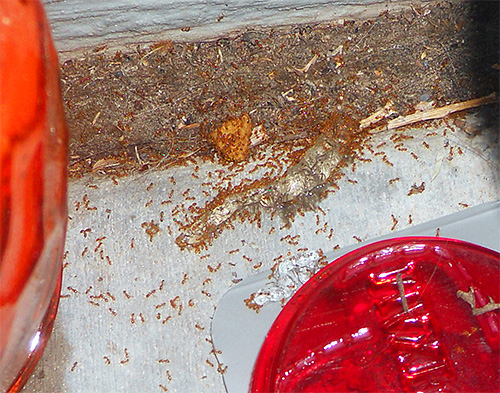
And in this photo you can see how domestic ants move in a row between a food source and a nest:

Speaking about the damage caused to humans, we can say that these domestic pests - like many of their fellow "in the shop" - spoil food, and are also capable of spreading various infections.
The main problem in breeding ants is that often their colonies have many nests combined with each other and located even in different apartments, garbage chutes and basements (super anthill). That is why the destruction of one such nest will not bring the desired effect: as long as there is a single colony, the ants will return and settle in the apartment again and again.
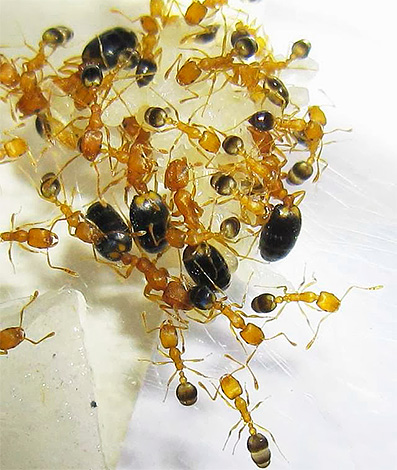
It is necessary to fight these small household pests together - it is better for all the residents of the house at once. Only in this case, the efforts will not be in vain, otherwise, only a temporary removal or reduction in the number of ants in each individual apartment can be achieved.
Almost any modern insecticide is suitable for the extermination of ants, but special poisoned baits, for example, in the form of gels, will be the best option.
Fleas: Defectors from Pets
Unfortunately, the list of domestic blood-sucking insects does not end with the bugs mentioned above. Fleas are another parasite that can often be found in human housing.
And further: Convenient and efficient electric insect exterminators

It is they and the bugs that most often bite in the house.
By and large, fleas do not have a “permanent place of residence”: they can be found both in an apartment and in the wild. In the house, they usually stay near the resting places of domestic animals, on which they parasitize, feeding on blood.
Fleas are common domestic blood-sucking insects that easily pass from one host to another (for example, to humans). They need blood both for nutrition and for reproduction - without it, the eggs inside the female simply do not develop.
The photo shows one of the most common fleas - cat (Latin name Ctenocephalides felis):

Potentially, fleas are capable of carrying many deadly diseases - from plague and typhoid to encephalitis and brucellosis, and therefore they must be dealt with especially diligently. But even if there is no infection in a single insect, its bite itself is quite painful, causes severe itching and, as a result, the appearance of pustular inflammation on the skin.
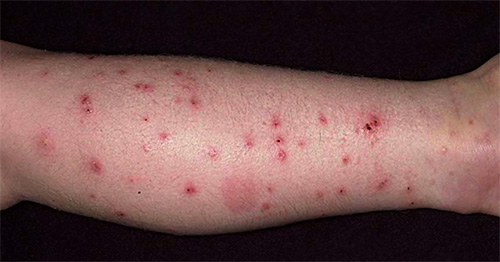
Deducing fleas in general is not so difficult if you act correctly. First, it is necessary to infect these parasites on pets, in their bedding and resting places. Secondly, you need to process the entire apartment, because flea larvae can be found in floor cloths, and in floor crevices, and behind baseboards.
Moth: a threat to food and clothing
Moths are a fairly large group of insects, which also includes several types of domestic pests. Some of them feed on groceries and cereals, spoiling food supplies, while others harm clothes, preferring mainly fur and woolen products (fur coat moth).
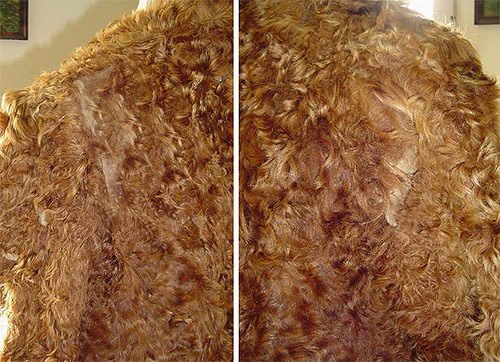
In the photo - food moth:

And here are photos of the clothes moth and its larvae:
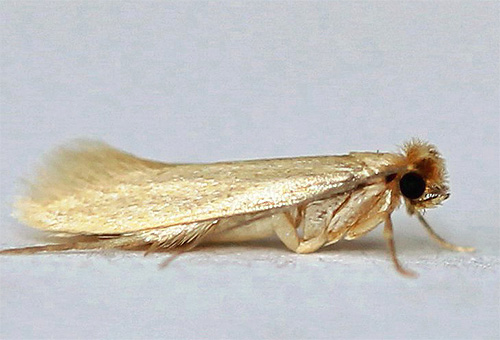

This photo shows a fur coat moth larva in a protective case:

All adult moths are butterflies. They are active domestic pests at the caterpillar stage, but adult insects may not eat at all.
That is why, killing a single moth butterfly at home, flying near the closet with clothes or in the kitchen, it is unlikely that it will be possible to achieve the destruction or at least reduce the number of these pests - most likely, the adult insect has already laid eggs, and the further “battle” should be directed directly against them and caterpillars, which hatch approximately 6-14 days after laying.
Clothes moth is removed with insecticidal preparations, and also - if this, of course, is possible - with high temperatures (up to 70 ° C) or, conversely, by freezing clothes. Folk remedies based on lavender and various other herbal preparations, unfortunately, will not rid the home of this domestic pest - they can only be used to prevent contamination of the premises.
The fight against food moths should be aimed primarily at the destruction of contaminated food.
Woodlice in the house are not exactly insects
But woodlice (as already mentioned at the very beginning) cannot be attributed to insects living in the house - these arthropods belong to the class of higher cancers.
This photo shows the common armadillo (Latin name Armadillidium vulgare):

And here is a rough woodlice, a more frequent guest in houses:
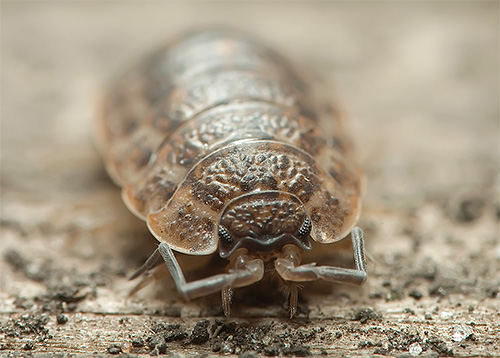
They, unlike, for example, typical bedbug parasites, do not cause much harm to humans: only occasionally woodlice spoil stocks of vegetables or (if they get there) damage young parts of indoor plants. However, meeting these miniature cohabitants is always unpleasant.
As a rule, wood lice appear in those rooms where high humidity is constantly maintained or there are water leaks: usually these are bathrooms and toilets. Here, there are also secluded dark shelters in abundance (woodlice, like cockroaches, do not like bright light), and a source of food - for example, a trash can in which you can eat various organic residues.
The existence of wood lice is to some extent connected with water (after all, they are still crustaceans), therefore, it is quite simple to remove them.

In most cases, for this it is only necessary to exclude the moisture that is vital for them: to dry the bathroom or, for example, to eliminate the leak in the faucet. If for some reason these measures do not bring the desired effect, then woodlice can be exterminated with any modern insecticidal agent (Get, Delta-Zone, Tsifoks, Dobrokhim FOS, etc.).
Leather beetles: enemies of books and clothes
The skin beetle is one of the most striking examples of an insect in a person's house, which the owner of the apartment usually does not know about cohabitation with. The reason for this is simple: adults of the kozheed beetle barely reach a length of 3.5 mm, and their larvae - 2 mm.
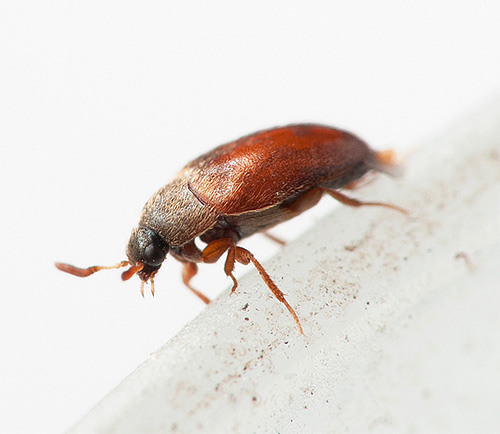
In general, there are a lot of different types of kozheed beetles, in nature they almost always settle where there is an abundance of any organic remains of the vital activity of animals, birds or other insects. If we talk about human housing, then here these domestic insects settle where there is paper, leather or clothing.

In apartments or houses, these pests feed on book bindings, wardrobe items, and even plain paper. It can be said that skin beetles in their food addictions are real “generalists”: their larvae can be found, among other things, in cereals, herbaria and insect collections of amateur entomologists. They are able to feed even on the remains of garbage in the dust and breed for years behind baseboards, where no one sees them.
The photo shows a museum skin beetle (otherwise - a museum beetle, in Latin Anthrenus museorum), which got its name in ancient times and is one of the most frequent pests of museum exhibits:

Important
However, damage to food and household items is not the worst thing that can be expected from leather beetles. It has been proven that these domestic pests can cause human infection with helminths and even some infectious diseases, so their timely destruction is simply necessary.
Most often, skin beetles are removed with various aerosol insecticides, but folk remedies in the case of these insects can be of great help. So, for example, the larvae of these beetles do not tolerate the smell of lavender and wormwood, so their use, if it does not exterminate insects, can be an excellent preventive measure.
Silverfish are harmless observers
Silverfish are perhaps the most "quiet" and almost harmless types of domestic insects. In terms of their lifestyle, they can be compared, for example, with wood lice: these small roommates of a person also love moisture, darkness and warmth.
The photo shows the most common species - sugar silverfish (otherwise - ordinary, Latin name Lepisma saccharina):
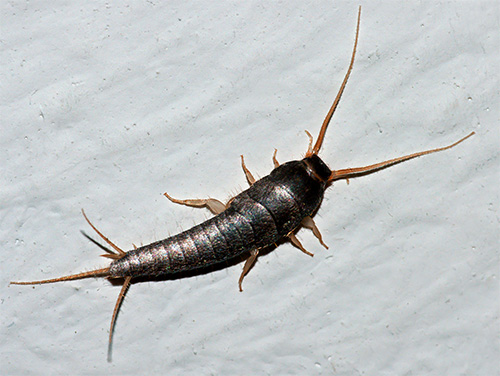
These domestic insects feed on various organic matter, which is found in dust, sugar on the table, bread crumbs, and sometimes everything that the leather beetles, which were mentioned above, prefer.
Silverfish never breed in large numbers and catch your eye mainly in the evenings, when the owner of the room, turning on the light, takes the insects by surprise (by the way, these human neighbors have an impressive speed for their size and quickly hide in saving shelters).
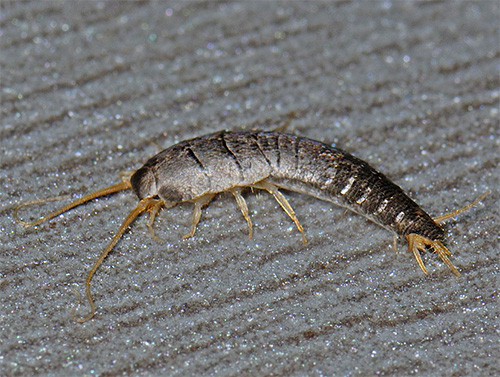
Silverfish are rarely targeted and are usually bred in parallel with other synanthropic insects. For this purpose, as a rule, various aerosol insecticides are used, although you can get rid of them in the simplest ways - by cold or dryness in the house.
And further: We caught bedbugs and tested the effect of GEKTOR powder on them - a pretty killer thing turned out to be ...
Spiders and their benefits
Spiders are another example of non-insect invertebrates living in the home. Their presence is perhaps the most terrible thing that can be expected from them: after all, spiders in a human dwelling are neither parasites nor pests.
On the contrary, these “roommates” can be called a kind of human helper in the fight against domestic insects, since their main “task” here is to catch flies, cockroaches and mosquitoes. Thus, if the spiders do not tighten all the corners of the room with their webs, they can be considered rather useful.
In this photo, one of the most frequent "neighbors" is a haymaker spider (otherwise a centipede spider, the Latin name is Pholcidae):
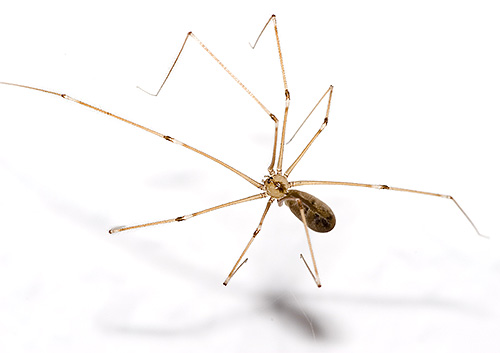
And here is a common cross-spider (Araneus diadematus):
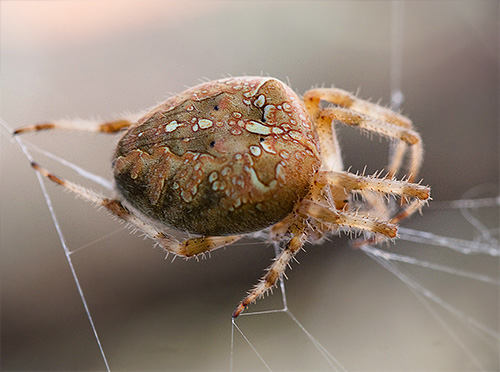
Spiders are rarely numerous in the house, and therefore it is not difficult to breed them: most often they are simply caught, for example, with a broom and thrown out into the street along with the cobwebs.
Lice: always there - both in the house and on the street
The louse is a classic blood-sucking parasite. These insects are not attached to the house, but directly to the person himself, and are not capable of living outside his body, or at least clothes. That is why it is impossible to call lice typical domestic insects.
The photo shows a head louse, which, among other things, is a carrier of some dangerous infectious diseases:

And the photo below shows a pubic louse, the presence of which is considered a venereal disease (another name is a flathead, Pthirus pubis):

Adult parasitic lice and their larvae spend most of their time clinging tightly to human hair, and to feed, they crawl to the surface of the skin every few hours. Their eggs in a dense shell are called nits and greatly spoil the appearance of the hair.

Due to the fact that lice feed on human blood and, accordingly, they constantly bite, their presence causes severe itching. To date, there is a large arsenal of specialized lice products: pediculicidal shampoos, sprays and combs.
Mosquitoes: guests for a few days
It is difficult to imagine a person who would not know what mosquitoes look like. These insects appear in the house for a short time only to drink blood and fly back to the street to lay their eggs.

Bloodsuckers are exclusively females (they need blood to produce eggs), but males, as a rule, feed on plant nectars.
The common mosquito, the most common biting parasite in our country (another name is the Pisk mosquito, Culex pipiens):

And the next photo shows a malarial mosquito, an insect commonly found in the homes of people living in the tropics, and carrying the corresponding disease. The photo shows how he holds his body - this is the main way to distinguish a malarial mosquito from his usual counterpart:
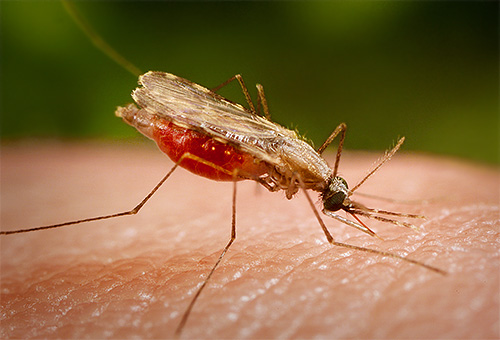
On a note
Many other species of mosquitoes are also capable of transmitting human life-threatening infectious diseases.Fortunately, this trouble practically does not affect our latitudes, and the only thing that a mosquito can be dangerous for the population of our country is the severe itching that appears after a bite.
The development of mosquitoes is always closely associated with water, so houses with flooded basements are an ideal place for the reproduction of these blood-sucking parasites. Also very often these insects are found in private houses and cottages, where there is always an accessible source of moisture nearby for them.

There are a great many remedies for mosquito bites today: these are ointments, creams, and various other forms of repellents. The main way to prevent the entry of these domestic insects into the apartment is mosquito nets fixed on the windows, as well as maintaining the basement and yard areas in good condition.
Flies in the house and harm from them
Flies are known to everyone as a "dirty" insect. Indeed, their whole life, to one degree or another, is connected with various kinds of waste, both of plant and animal origin.
In a person's house, flies live and actively reproduce, provided that there are organic residues - for example, food. Often they settle where there are domestic animals, in whose excrement and food residues the fly larvae successfully develop. In addition, often these insect pests breed in the attics of houses in the deposits of bird droppings.
In the photo - a gray blowfly (Latin name Sarcophagidae):
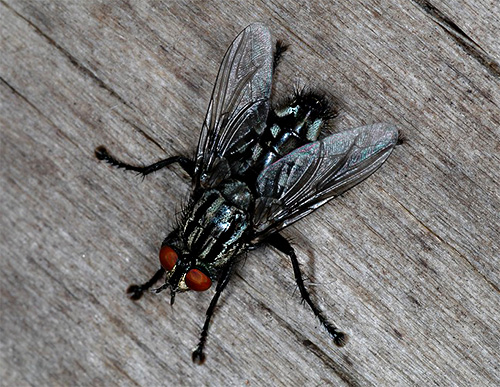
And this photo shows a housefly, which got its name because it lives exclusively next to a person, and is extremely rare away from its habitat:
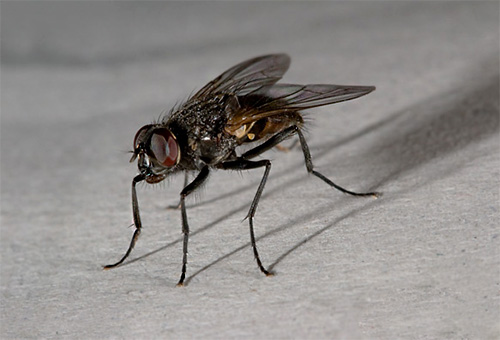
Knowing at least a little about the way of life of flies, it is easy to guess about their harmful value for humans.In addition to the fact that these domestic insects simply contaminate products and often make them unsuitable for consumption due to laying eggs (for example, in pieces of meat or fish), flies are also dangerous because they are able to transfer pathogens from excrement to human food on their paws. various infectious diseases and helminth eggs.

Flies are removed by direct extermination using a variety of insecticides, hanging glue traps and banal maintenance of cleanliness in the room.
Springtails
In a person’s apartment, springtails are not uncommon inhabitants of flower pots, and if we talk about home gardening, they can often be found in greenhouses and greenhouses.
Springtails are very small domestic insects (some modern scientists tend to single them out as a separate class). In the photo you can see these miniature "neighbors" on a clod of earth from a flower pot:
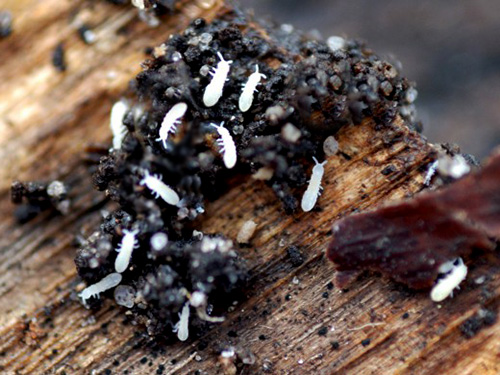
Springtails begin to harm only when there are a lot of them: they damage the underground parts of plants and - occasionally - low-lying leaves.
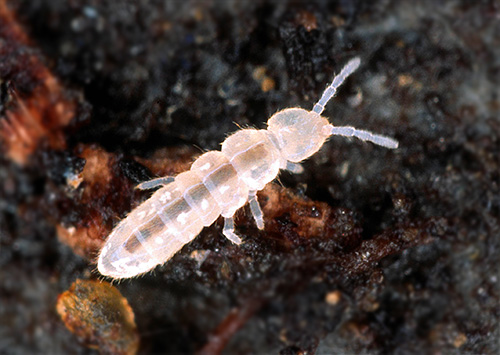
These domestic insects live only in a humid environment, therefore, when they appear in the soil of plants, it is necessary first of all to try to reduce watering as much as possible. In addition, experienced flower growers advise adding special preparations to the water for irrigation, and as a preventive measure, use prepared disinfected soil for planting plants and create drainage in the pot that will prevent water from accumulating.
Kivsyaki and centipedes
Centipedes, nods and centipedes, although they do not belong to the class of insects, can nevertheless be called domestic invertebrates.In general, their infrequent appearance directly in a person’s dwelling does not bring any harm, however, frankly, their appearance is not entirely pleasant.
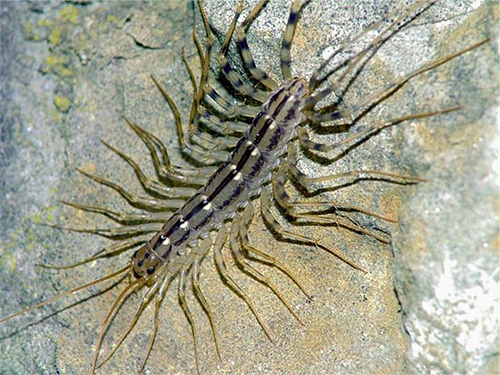
Kivsyaki, along with earthworms on the lands of household plots, play a significant positive role in the formation of humus, and centipedes actively exterminate the larvae of harmful agricultural insects, so all of them can rather be attributed to creatures useful to people than to pests.
Most of these invertebrates enter the human dwelling with the onset of cold weather - they prefer to hide in dark, warm and humid places (mostly in basements, rarely in bathrooms and toilets).
In the photo - Crimean kivsyak (Latin name Pachyiulus flavipes), a fetid creature that settles together with wood lice in humid places:
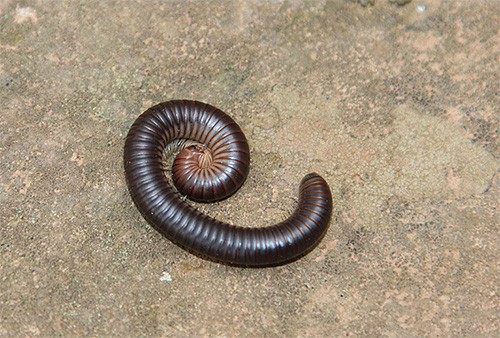
And here is an ordinary flycatcher, a predatory creature that feeds on mosquitoes, ants, small cockroaches and flies:
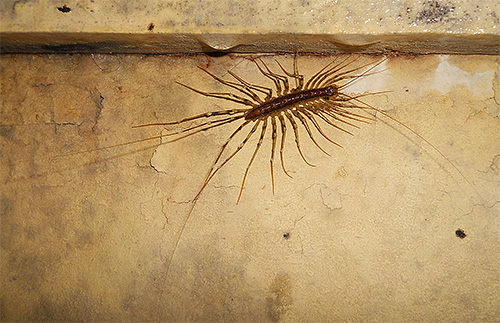
All centipedes rarely breed in large numbers and therefore do not require special breeding.
Insects - pests of a wooden house
A separate discussion deserves a number of insect pests of a wooden house. They do not live indoors and are not shown to the eye, but their active life activity can lead to a decrease in the strength of wooden structures and even the subsequent destruction of the building.

Among such insects living in a wooden house, one can distinguish wood-boring ants, grinder beetles, some moths, and in the south of our country - termites. To protect against these pests, house structures are treated with special stains or impregnations even at the construction stage, and then regularly painted.
The photo shows a red-breasted wood borer ant (Latin name Camponotus herculeanus):
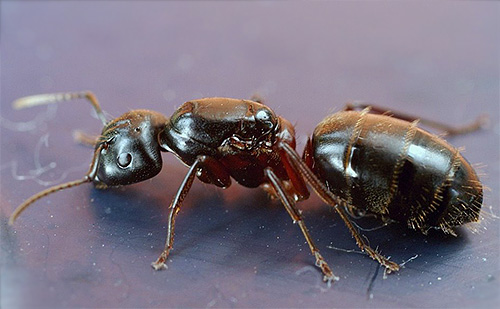
And here is the grinder beetle:
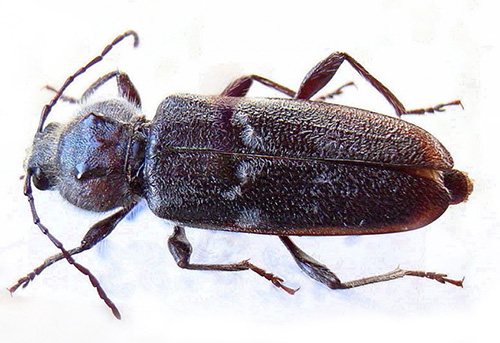

In this photo you can see a termite - a typical inhabitant of Turkmenistan, sometimes penetrating into the southern regions of our country:
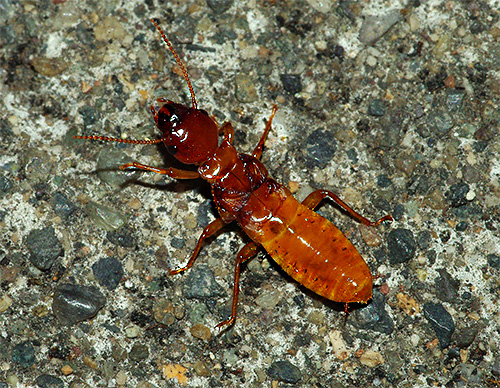
"Straight" insects in the house
All other insects that can be found in a person's house are most rationally attributed to random "stray" guests. This group includes various butterflies, beetles, cicadas, stink bugs, ladybugs, as well as wasps, bees and hornets.
Purposefully destroying them is not worth it, but for your own peace of mind and safety, it is enough just to release the insects through an open window. Here are just some of them you need to be careful - they can sting (for example, a hornet) or badly spoil the air (for example, a stink bug).
About pests and how to get rid of them

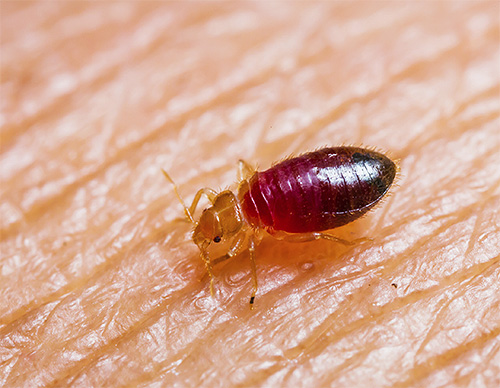
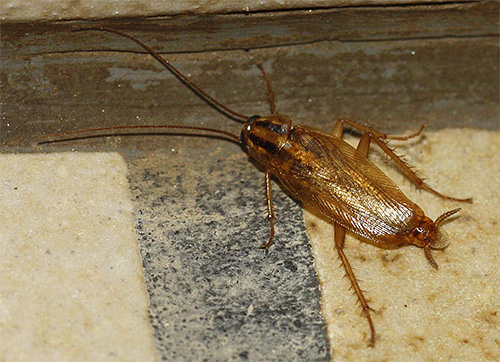

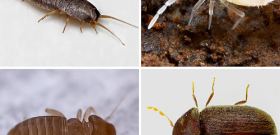


And by the way, the flycatcher is not a parasite, but vice versa.She eats flies, cockroaches and so on.
Thanks for the interesting article, I learned a lot of useful information and even changed my view on many different insects. It turns out that I have a couple of friendly neighbors, I was looking for information about them, I even began to respect them)) If I see such guests at someone's house, I convincingly ask them not to destroy them.
How to sleep now?!
No way
And you won’t fall asleep (I’m sitting with the lights on.
Yep, me too.
Count elephants
And I'm tired of fighting the skin beetle larvae! A day later, cleaning, I already tear off the plinth, process it. A month later I look - they are there again. I'm going crazy soon...
Tell me, do they fly? Something similar happened. Thank you.
I have spiders in my toilet every day, everything is different, and there were no bugs. More moths and that's it.
There are no such beetles that live on my list.
In a village house, in the attic, whole clouds of flies swarm. They are smaller than Drosophila. In the evening, flies plant a dense layer on the ceiling, and when you light an electric light bulb, they rotate like a cloud around the lamp. Flies do not land on people or food. You stand in a cloud of flying insects.
Flies appear closer to the middle of summer. Last year, the flies moved from the attic to the rooms on the second floor. When you come home after winter, millions of corpses lie on the windowsills.
There are no animals in the village. Among the insect specimens that you present, "my" flies are absent.
With deep respect and hope for help, Nina Timofeevna.
Turn on the fumigator or spiral. And better a sulfur checker, which greenhouses poison. Thank you.
Gray parasites sit on white. Most often on the window, but once noticed in the bathroom ... They look like ticks. What could it be?
At the end of winter, something began to rustle in the cabinets (and earlier too). Opened the bottom. He took out a stack of old magazines and laid them on the floor. And just a HUGE beetle crawled out of there! The size of a large hazelnut, even more. And he creaked. I was scared, to be honest. I decided to catch, but unsuccessfully because of fright. The friend flinched.
The beetle was brown. Hemispherical, almost round. He ran fast. The legs are small. I repeat - very meaty.
He creaked without threat, something under his breath, like an old grandfather, grumbled. This was the point, they say - why are you bothering to live (not, well, really, unscientific of course) ?! There was also a smell from him all these days, a little unpleasant.
The question arises - what did the man eat half the winter? If you came from the forest in autumn?
He was in hibernation, woke up by spring. You arrived, he was hungry, so he grumbled)) He creaked with his hard wings, most likely. Can you attach a photo? Sincerely.
Thank you 🙂 Everything was explained in such detail and interestingly) However, the conclusion is: those who are terrible for us and are beneficial, we destroy them first because of their appearance, rather than real pests.
In the new house, I made floors from ash, but a problem arose - parasites appeared, with 1 cm in length, like worms, and they made holes in the floors, leaving heaps of sawdust behind them. I don't know how to deal with it. Tell me who knows what to do.
I have flying small silent insects at home, I don’t know what they are called. I use dichlorvos - does not help. After the bite, the itching is the strongest, I will be glad if you help. Thanks in advance.
Same problem! Tiny (1-2 mm) black flying midges, when touched, emit a strong smell of "perfume" (not nasty, rather, even pleasant, aroma). They bite hard, the bites become inflamed and itchy terribly. What kind of attack is this?!
Spiders live on the loggia, and I don't touch them. Pauli family 🙂
I did not find here what I found at home ... These black beetles, 2-4 mm in length, covered with black hairs, or spikes, with a yellow abdomen.
Small (about 1 cm) black hairy worms appeared in my house in the village. I find them at the sink, and in cookies, and in wobble. Appear from nowhere, jump or something, I don’t understand. But I really don't like it!
We have strange insects in our private house: black, two antennae on the pope, two antennae on the head, and 6 legs. I don’t know what it is, but they climb into the kettle and into the bucket of water. You get up in the morning, and they swim there and climb on the floor. What's this?
It's probably your earwig.
Is this earwig a pest or not? It also began to appear from somewhere.
Along the way, it's cockroaches.
I'm scared to go to bed now. And I want to put my cat out! (
I have a ground floor, and in July every year my windows, or rather, mosquito nets, are covered with some kind of midges, you can’t open the window. And they, it seems, do not bite, there are just so many of them that if you open the window, they pour handfuls on the windowsill. Is it a moth, or some kind of aphid. Poplars grow near the windows. Tell me, please, who is it, but it is better how to deal with them.
Beloved in your list is what is found in my bathroom.Dark gray small flies, as if made of dust. Immediately you can clap and after them the dust at the place of clap. What could it be?
And I have small (1 mm) gray or black crawling along the walls, the head is small, the body is slightly larger. You can even press down with your finger, although they try to run away, after that a dirty spot remains on the wall. The wall is white. I even noticed them on the wallpaper. And I also have silverfish, mostly crawling along the ceiling and along the foam cornices, so it’s impossible to catch them. Where they come from is not clear.
People, help! What to do? I have black dots crawling in my apartment, they are like a segment from a circle. I recently got a cat, I was very cold, I almost died, I was sitting on the street. I brought him into the house, feed and sing him in the evening. I come the next day, it's impossible to itch, all my animals itch. Besides the cat, there are living creatures! The cat was brought into the house in February-March 16. I have already tried by all means to kill these black dots. It doesn't work, what else to try? I don't know if you can give me some advice. It's just that parents say that it's nervous! This cannot be, because I saw these insects that I suffer from. And parents, I think, did not see. I don't know what to do anymore. They yell at me when I spray anti-flea agents! And I don’t know what those same black dots are called, I already think that they are feathers. And they don't know what kind of creatures they think I'm impressionable too. People, advise what to do? I've been looking on the internet and see what.
Houses crawl mostly in dark places, such black worms, not worms, xs, what is it. The body is elongated, like a drop, thin, 2-3 mm in length.Sometimes you pick up something that has been lying on the floor for a long time, and under it these things crawl. Even in the toilet they sometimes crawl out. Works well with ants. Also ants in the toilet sometimes run around. What kind of insects and how to deal with them?
A bug started up, white-black-red coloring ...
Didn't find what I got. A small insect, 5 mm, with an absolutely flat teardrop-shaped body. It rises on the legs by 1-2 mm. Brown color. I notice one individual every few days, but I'm afraid if they breed somewhere where I can't get it? Can, who faced such?
Maybe sand fleas? I call them home… Jumping on their feet, etc.?
In our wooden house only this year a beautiful bug with a red pattern on the back appeared, about a centimeter long. Who is it?
Hello. We have strange creeping insects in our apartment. They poisoned the apartment - everything went away, but after a while they reappeared. I saw them on the balcony, on the window frame. Tiny, like a dot, they are killed only if they are pressed down with nails, they burst with a sound. They have bites. On the body sometimes crawl.
My sudden residents are not on the list either. Small black bugs, about the size of an ant, sometimes a little larger. To bite, like, did not notice. I noticed it a couple of times in the bathroom, several times in kitchen cabinets and on myself. Who are they ... It seems that they don’t even cause disgust.
P.S. From the article, of course, itched all over.
We live in a private house. Ladybugs come to us every autumn, a lot, terribly. And yes, they bite...
Didn't pick up for about 1 month.Before that, there was nothing, but then he swept under the table and removed from there pieces of 4 small centipedes, similar to a leather beetle, but without a “tail”. Tell me what is it? I'm afraid to go to bed. I think it's harmless, but still!
Didn't clean the room for about a month. There was simply no time ... I noticed that some insects were crawling along the edges of the baseboards. He cleaned up and completely spilled the whole room with dichlorvos. After 2 months, I removed some kind of insect from my leg with decent-sized "mandibles" - about 0.5 cm in the extension. It was about 0.7 cm long. By “obesity” it was about 0.5 cm. I “soaked” it, but I didn’t find a photo anywhere on the Internet, what kind of “beast” is this. A little later I will try to post a photo of this insect.
I did not find similar ones, they are black, behind two paws are yellow. Size - from 1 to 1.5 cm.